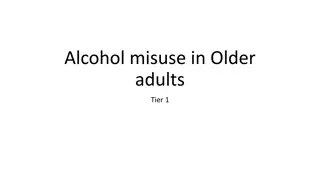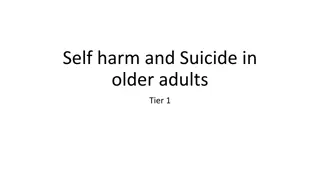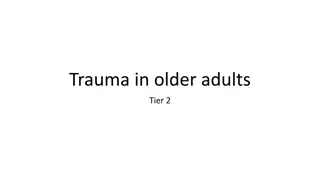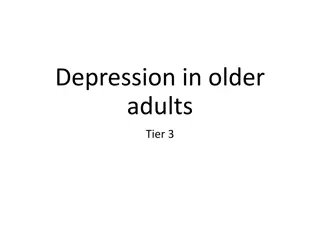Targeting Emotions to Facilitate Behavior Change in Older Adults
Efforts in changing health behavior have traditionally focused on social and cognitive factors, but recent evidence highlights the importance of affective states in decision-making and behavior change. Janey Peterson discusses the role of emotions in achieving and sustaining behavior change to benefit older adults. The presentation delves into the impact of affect on behavior change and maintenance, emphasizing the need to understand these mechanisms better. Through the exploration of the Hedonic Principle, measurement of affect, proximal and distal outcomes, and the influence of negative affect on stress and health behaviors, a broader perspective on behavior change is presented.
Download Presentation

Please find below an Image/Link to download the presentation.
The content on the website is provided AS IS for your information and personal use only. It may not be sold, licensed, or shared on other websites without obtaining consent from the author.If you encounter any issues during the download, it is possible that the publisher has removed the file from their server.
You are allowed to download the files provided on this website for personal or commercial use, subject to the condition that they are used lawfully. All files are the property of their respective owners.
The content on the website is provided AS IS for your information and personal use only. It may not be sold, licensed, or shared on other websites without obtaining consent from the author.
E N D
Presentation Transcript
Janey Peterson, "Achieving and Sustaining Behavior Change to Benefit Older Adults" Dec 6-7, 2018 TARGETING EMOTIONS TO FACILITATE BEHAVIOR CHANGE JANEY PETERSON, EdD, MS RN Associate Professor of Clinical Epidemiology in Medicine Associate Professor of Clinical Epidemiology in Cardiothoracic Surgery Weill Cornell Medicine
Janey Peterson, "Achieving and Sustaining Behavior Change to Benefit Older Adults" Dec 6-7, 2018 Background Efforts aimed at changing health behavior usually focused on theoretical frameworks comprised of social and cognitive factors (e.g., self-efficacy, knowledge, values) (Conner & Norman, 1996, 2017) Health behavior interventions have been limited in effectiveness even when exposure to intervention components is adequate, and delivered with high fidelity (Breitenstein, 2010) Converging evidence over the past 2-3 decades suggests that affective states are critical elements in health decision-making and health behavior change (Damasio, 1994; Lerner & Keltner, 2000, 2001; Loewenstein & Lerner, 2003), yet the mechanisms by which affect influences behavior change and change maintenance remains poorly understood
Janey Peterson, "Achieving and Sustaining Behavior Change to Benefit Older Adults" Dec 6-7, 2018 The Hedonic Principle Positive shift in Positive affective response More frequent performance of behavior hedonic valence Less frequent performance of behavior Negative shift in hedonic valence Negative affective response Kahneman, Diener,1999
Janey Peterson, "Achieving and Sustaining Behavior Change to Benefit Older Adults" Dec 6-7, 2018 Measurement of affect State affect Trait affect Eudaimonia: meaning, purpose in life long term measures Hedonia: well-being, happiness short-term measures Proximal Outcomes Distal outcomes Kahneman, 1999; Waterman, 1993; Pressman, Jenkins & Moskowitz, 2018
Janey Peterson, "Achieving and Sustaining Behavior Change to Benefit Older Adults" Dec 6-7, 2018 Negative affect stress, depression, anger, fear, disgust Biomarkers Coronary angioplasty patients demonstrate significantly elevated levels of C-reactive protein in response to mental challenges In lab studies where stress is induced in healthy people, subjects IL-6 levels increased Health Behaviors In the Copenhagen City Heart Study, stress was inversely related to physical activity levels In the INTERHEART study, those with greatest stress had significantly higher BMI and cholesterol, and were more likely to smoke (P < 0.0001 for all) Several studies have found that men with high job demands had the greatest progression of carotid artery atherosclerosis over four years Clinical Outcomes Depressed people are more likely to develop CHD (meta-analytic effect size, 1.5 2.7) and people with established CHD who are depressed have increased risk of morbidity and mortality (meta- analytic effect size, 1.6 2.2)
Janey Peterson, "Achieving and Sustaining Behavior Change to Benefit Older Adults" Dec 6-7, 2018 Positive affect Epidemiologic studies- pleasurable emotions (i.e., happiness, joy, pleasure, contentment) Intervention studies- positive mood state induced by small events, such as receiving a small, unexpected gift, seeing a few minutes of comedy, or receiving a report of success on a small task (Ashby, Valentin, & Turken, 2002) Effects of induction of positive affect Increases positive feelings Enhances self-efficacy Improves flexible thinking Increases intrinsic motivation Promotes pro-social behavior Stimulates prioritization of effortful tasks Promotes working toward a goal Enhances engagement in healthier behaviors
Janey Peterson, "Achieving and Sustaining Behavior Change to Benefit Older Adults" Dec 6-7, 2018 Positive affect and health outcomes MORTALITY PA extends life in healthy older adults (Zhang & Han 2016) MORBIDITY High PA predicts resistance to both flu and cold (Cohen et al. 2003) High PA associated with a reduced risk of frailty over 2 years of follow-up (Park-Lee et al. 2009) Higher PA associated with slower functional decline (e.g., inability to walk, self-feed, and bathe) in older adults (Hirosaki et al. 2013) Purpose in life protected against decline in walking speed over four years in HRS (Kim, 2017) PHYSIOLOGICAL OUTCOMES Lower inflammation, C-reactive protein, IL-6 (inconsistent) Lowers HR/BP/lipids, lowers cortisol, increases heart rate variability, improved healing, allostatic load Pressman, Jenkins & Moskowitz, 2018 Steptoe, 2019
Janey Peterson, "Achieving and Sustaining Behavior Change to Benefit Older Adults" Dec 6-7, 2018 Induction of positive affect studies Interventions used to induce positive affect Thinking positive thoughts Unexpected small gifts Practicing gratitude Engaging in mindfulness Outcomes Improved well-being (including PA) Decreased depressive symptoms, with small effect sizes Increased physical activity
Janey Peterson, "Achieving and Sustaining Behavior Change to Benefit Older Adults" Dec 6-7, 2018 Positive affect/self-affirmation enabled CVD patients to overcome high depressive symptoms and stress Peterson JC. The adaptive neuroplasticity hypothesis of behavioral maintenance. Neural Plast. 2012; 516364
Janey Peterson, "Achieving and Sustaining Behavior Change to Benefit Older Adults" Dec 6-7, 2018 Stress buffering model of positive affect Pressman, Jenkins & Moskowitz. Positive Affect and Health: What Do We Know and Where Next Should We Go? Annu Rev Psychol. 2018 Sep 27.
Janey Peterson, "Achieving and Sustaining Behavior Change to Benefit Older Adults" Dec 6-7, 2018 Where to go next Gaps in the literature Next steps 1. Studies underpowered and poorly controlled 2. PA not yet demonstrated to be a mediator of health outcomes in intervention studies 3. Stress-buffering effects of PA poorly understood 4. More work to assess PA arousal levels (e.g., high, mid, and low arousal) and health outcomes in different conditions and age groups 1. Larger, well-controlled studies in older adults with chronic disease 2. Studies with well-defined mediators & carefully measured clinical outcomes 3. Carefully measure stress, evaluate as mediator & moderator 4. Employ formal PA instruments (e.g., PANAS), evaluate arousal levels in disease/age groups























